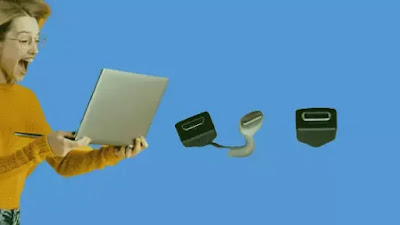USB Type-C was introduced 7 years ago. USB Type-C connection technology has been very common and useful since its existence in the market.USB Type-C is used as a charging cable and USB port in new generation technologies such as laptops, smartphones and tablets.
So, what is the feature of this connection type? Khadamtech completely explain that What is the difference between Micro USB and USB Type-C ?
What is USB Type-C?
USB Type-C is a smaller and symmetrically designed connection type that is easier to use than other connections.With USB Type-C, the connection speed has reached the speed of USB 3.1.The cables of this state-of-the-art connection are more electrically charged, so they can charge laptops and tablets.
Information About USB Type-C
The difference between Micro USB and USB Type-C is that the USB Type-C connection has the cable to fully charge the battery of the thinnest smartphone Oppo Reno 5 and laptop computers.USB Type-C eliminates excessive cable clutter.Because USB Type-C performs all hardware operations on your laptop, desktop or tablet with a single cable.With this new generation Type-C HDMI connection cable, you can connect your speaker to a computer and even get 4K display technology.
As it is known, the connector input of the USB Type-A connection creates some difficulty while sitting in the socket of the computer.However, Type-C is easier than others for computer inputs thanks to its symmetrical design.If USB Type-C turns into a single connection type in the future, there will be no need to carry an extra adapter, power cable or charger for other smart devices.
Features and Benefits of USB Type-C Connection
With its characteristic elliptical shape, USB Type-C provides high quality transmission of video and audio signals at the same time.It shows a superior performance in mobile devices, laptops and other smart technological devices.
Let's examine the prominent features and advantages of USB Type-C connection.
20 Gbps Data Transfer Rate
USB Type A is powered by the USB 3.2 Gen 2 version, with speeds of up to 10 Gbps.However, with the theoretical transfer rate corresponding to USB Type USB 3.2 Gen 2×2 version, it can go up to exactly 20 Gbps.
Supporting Different Protocols
USB Type-C supports DisplayPort, Thunderbolt, PCI Express, HDMI and MHL signals.If the appropriate converter and cable converter are added to the USB Type-C connection, it can even be connected to a VGA monitor.
Ability to Connect to All Devices
With USB Type-C connection cables, it is possible to make USB connections with the help of adapters and cables even without Type-C input support.Therefore, you can continue to use the devices you have at hand.
Enhanced Electromagnetic Compatibility
Electromagnetic compatibility is the operation of a device in an electromagnetic environment without being affected by other stimuli.Thanks to its upgraded electromagnetic compatibility, USB Type-C ensures better performance of all connected devices.
What are the Differences Between Micro USB and USB Type-C?
Today's technology has led to the use of more advanced and trouble-free devices with the introduction of USB Type-C connection into our lives.One of the most used types of USB by people is Micro USB.Next comes USB Type-A and USB Type-B, respectively.
However, USB Type-C has much more technical hardware and improved data speed than these connection types.
Let's examine together what is the difference between Micro USB and USB Type-C .
Micro USB Traditional USB Type-C Is Universal
Micro USB types are small USB connections, as the name suggests, used in devices such as phones, cameras and mp3s.So it can be said that there are standard connections for Micro USB.USB Type-C is a universal connection system that supports all new generation devices.
USB Type-C Has USB 3.2 Standard
Micro USB only has the necessary hardware for the USB 3.0 standard, while USB Type-C has the USB 3.2 standard, leaving other USB types behind.
USB Type-C Dual-Sided Data Transfer
When asked what is the difference between Micro USB and USB Type-C, the double-sided data transfer feature for USB Type-C can be mentioned.USB Type-C has the power to work by combining 2 USB 3.1.
USB Type-C Has Faster Power Delivery
Micro USB cables have the ability to charge smartphones with their 15-watt power.However, USB Type-C cables working with Power Delivery support have 100 watts of power transmission.This energy can even meet the power needs of highly advanced technology gaming computers on the market.
USB Type-C Data Rates with Micro USB
The difference between Micro USB and USB Type-C is most evident in the data rate comparison. Micro USB connection lags far behind in terms of data rate when compared to USB Type-C.A standard Micro USB data transfer rate is in the 480 Mbps band.However, the data transfer rate of USB Type-C is up to 5 Gbps.




0 Comments